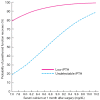Defining the syndromes of parathyroid failure after total thyroidectomy
- PMID: 25713783
- PMCID: PMC4321048
- DOI: 10.3978/j.issn.2227-684X.2014.12.04
Defining the syndromes of parathyroid failure after total thyroidectomy
Abstract
Acute and chronic parathyroid insufficiency syndromes are the most common complication after total thyroidectomy. Permanent hypoparathyroidism imposes an important medical burden on patient lifestyle due to the need for lifetime medication, regular visits and significant long-term costs. Its true prevalence has been underestimated due to lack of clear definitions, inadequate follow-up and conflicts of interest when reporting individual patient series. The aim of this review is to propose precise definitions for the different syndromes associated to parathyroid failure based on the follow-up and management of patients developing hypocalcemia (<8 mg/dL at 24 hours) after first-time total thyroidectomy for cancer or goiter at our unit. Short and long-term post-thyroidectomy parathyroid failure presents as three different metabolic syndromes: (I) postoperative hypocalcemia is defined as a s-Ca <8 mg/dL (<2 mmol/L) within 24 hours after surgery requiring calcium/vit D replacement therapy at the time of hospital discharge; (II) protracted hypoparathyroidism as a subnormal iPTH concentration (<13 pg/mL) and/or need for calcium/vit D replacement at 4-6 weeks; and (III) permanent hypoparathyroidism as a subnormal iPTH concentration (<13 pg/mL) and/or need for calcium/vit D replacement 1 year after total thyroidectomy. Each of these syndromes has its own pattern of recovery and should be approached with different therapeutic strategies.
Keywords: Definitions; hypocalcemia; hypoparathyroidism; parathyroid splinting; total thyroidectomy.
Figures


References
-
- Pattou F, Combemale F, Fabre S, et al. Hypocalcemia following thyroid surgery: incidence and prediction of outcome. World J Surg 1998;22:718-24. - PubMed
-
- Bhattacharyya N, Fried MP. Assessment of the morbidity and complications of total thyroidectomy. Arch Otolaryngol Head Neck Surg 2002;128:389-92. - PubMed
-
- Abboud B, Sargi Z, Akkam M, et al. Risk factors for postthyroidectomy hypocalcemia. J Am Coll Surg 2002;195:456-61. - PubMed
-
- Hadker N, Egan J, Sanders J, et al. Understanding the burden of illness associated with hypoparathyroidism reported among patients in the paradox study. Endocr Pract 2014;20:671-9. - PubMed
Publication types
LinkOut - more resources
Full Text Sources
Medical
